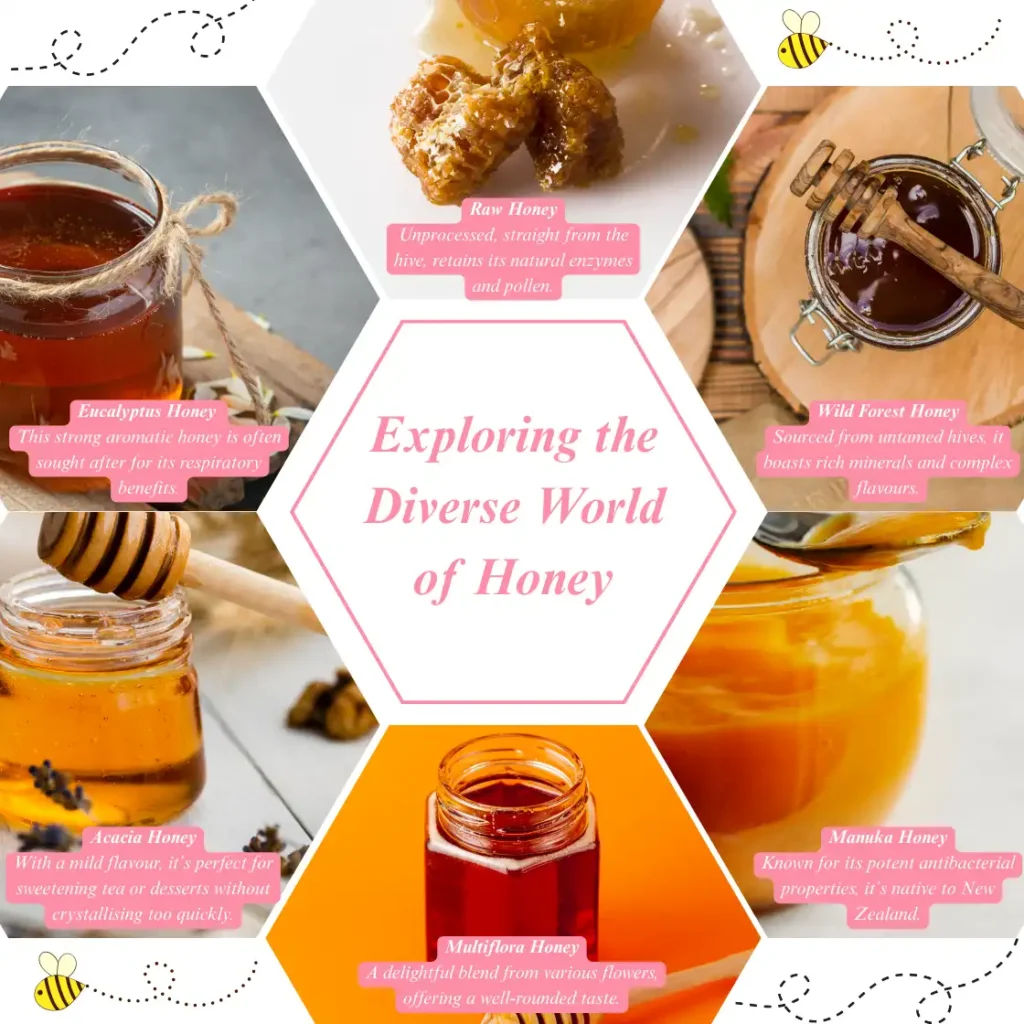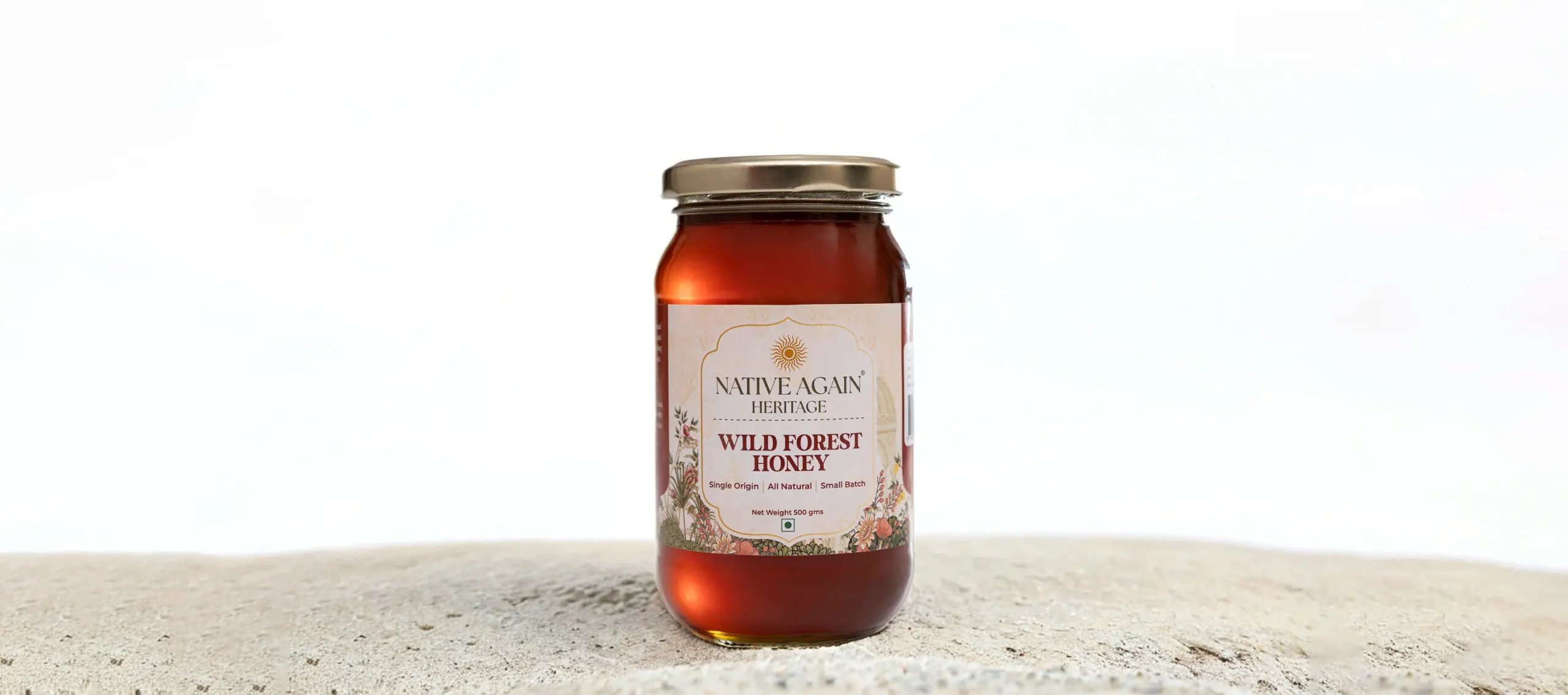Pure or Fake Honey? 5 Ways to Spot the Truth Before You Buy

Table of Contents
Introduction
You find yourself standing in the supermarket aisle, confronted by an enticing wall of honey jars – each one promising to be “pure,” “natural,” or “100% real.” The golden labels glimmer under the bright lights, and the charming branding makes it hard to resist. But just then, a little voice in the back of your mind whispers,
“Is this really honey, or just sugar in disguise?”
For centuries, it has represented more than just a sweetener. It’s been a symbol of health and vitality – drizzled over warm, fresh bread, swirled into steaming cups of tea, and used to soothe a stubborn cough. Yet today, the real challenge isn’t just finding honey; it’s uncovering the truth behind the label.
The Essence of Honey
It comes to life through the diligent work of bees, who transform sweet nectar into a rich, nutrient-packed syrup. With its naturally occurring antioxidants, anti microbial activity, enzymes, and plant compounds, it can work wonders for your health, calming coughs and aiding in wound healing. But alas, the bigger challenge today isn’t about why it’s good for you; it’s about ensuring you’re actually bringing home the genuine product.

Research confirms honey’s broad health potential. A 2025 review in Food Research International highlighted its antioxidant and immune-boosting properties in both traditional and modern medicine contexts, while another comprehensive review published in Nutrients (2023) found that it supports cardiovascular, metabolic, and digestive health¹,².
Likewise, The Journal of Scientific Research and Reports described natural honey as a “potent therapeutic agent” with properties that enhance immunity, heal wounds, and protect against oxidative stress⁴.
FUN FACT
Did you know that raw honey doesn’t go bad?
Jars discovered in ancient Egyptian tombs were still edible!
The Bitter Truth About Adulteration

Behind those beautifully crafted jars lies a troubling reality. Many commercial honeys have been diluted with cheap sugar syrups, artificially flavoured, or overly filtered until their natural goodness is stripped away. Global studies have revealed alarming numbers of store-bought brands failing purity tests, as what’s inside doesn’t match the bold claims on the label. So, how can you safeguard yourself from this sweet deception? It’s time to channel your inner label detective.
The Food Safety and Standards Authority of India (FSSAI) has documented widespread adulteration, where several brands failed purity tests³.
This means what’s inside often doesn’t match the bold “100% pure” claims on the label. It’s time to channel your inner label detective.
The Smart Shopper’s Honey-Label Guide
Picture yourself clutching a jar, your heart racing as you flip it over to examine the label.
Here’s a quick cheat sheet to help you navigate:
- – Ingredients list : It should simply state “Honey.” If you spot cane sugar, corn syrup, or anything else, place it back on the shelf.
- – Total sugars ≈ total carbs : The carbohydrates almost entirely come from its natural sugars. If these numbers don’t align, something’s amiss.
- – Calories per 100g : Real ones typically falls in the range of 300–330 kcal.
- – Protein & fat : Nearly negligible.
- – Sugar profile : Fructose and glucose should dominate; sucrose should be less than 1% (and never more than 5%).
- – Other disaccharides (like maltose or lactose) : Should be under 5%.
- – No “other sugar sources” : If you see them listed, walk away – it’s not pure.
These label checks align with purity benchmarks outlined in FSSAI’s Food Safety and Standards (Labelling and Display) Regulations, 2020⁵.
These valuable insights require no lab; just your keen eyes and a smidge of knowledge.
Pink Tiger Verified
Of course, even labels can deceive. That’s why Pink Tiger takes the guesswork out of your hunt – verifying authenticity through independent third-party lab tests. Our Pink Tiger Verified Native Again Wild Forest Honey isn’t merely “claimed pure”, it’s proven pure.

Quick At-Home Purity Clues
If you’re curious, you can also try these classic checks:
- – Thumb test : Pure stays put; fake one spreads out like a lazy puddle.
- – Water test : Pure one will sink like a stone; adulterated varieties dissolve quickly, vanishing under the surface.
- – Cotton test : Pure burns steadily like a focused flame; fake one crackles, betrayed by the moisture it contains.
- – Smell & taste : Real one offers a rich, floral aroma and layers of flavour, while counterfeit versions provide only flat sweetness.
These home tricks are simple, but when in doubt, certified testing remains the gold standard.
While these are quick indicators, scientific reviews, including one in the Saudi Journal of Biological Sciences , emphasize that advanced lab analysis remains the most reliable way to confirm honey purity⁶.
The Sweet Conclusion
It holds a cherished place in our kitchens and hearts. It’s important to distinguish between pure honey and imitation. By choosing pure, you’re not just sweetening your food; you’re honouring nature’s golden gift.
Disclaimer : This content is for informational purposes only and is not a substitute for professional medical advice, diagnosis, or treatment. Always consult a qualified healthcare provider for any questions or concerns regarding your health.
Frequently Asked Questions (FAQs)
1. Does crystallized honey mean it’s fake?
No, crystallization is actually a sign of purity! Natural tends to solidify over time due to its high glucose content. Gently warm it in a water bath to bring it back to liquid form without losing nutrients.
2. Why do some look lighter or darker?
The color depends on the nectar source. For example, eucalyptus or forest honey is usually darker and richer, while clover or acacia honey appears light and mild. Color variation doesn’t indicate quality or purity.
3. How can I be sure I’m buying pure honey without lab testing?
Look for transparent sourcing and third-party verification on the label. Brands that publish lab reports or purity certifications like Pink Tiger Verified Native Again Wild Forest Honey, provide proof of authenticity and quality.
4. Why does some honey taste slightly sour or tangy?
This could be due to natural fermentation if it wasn’t stored properly or contained excess moisture. Always store in a cool, dry place with the lid tightly sealed.
5. Can pure honey go bad?
No, Pure one doesn’t spoil if stored properly. Its natural enzymes and low water content prevent microbial growth, that’s why archaeologists have found honey in Egyptian tombs still fit for consumption!
References :
1. Mohamed, Abdelaziz, Liming, Yuan, & Kai. (2025). Health benefits of honey: A critical review on the homology of medicine and food in traditional and modern contexts. https://www.sciencedirect.com/science/article/pii/S2095754825000195
2. Palma-Morales, M., Huertas, J., & Rodríguez-Pérez, C. (2023, July 6). A Comprehensive Review of the Effect of Honey on Human Health. Nutrients. https://pmc.ncbi.nlm.nih.gov/articles/PMC10346535/
3. Detect adulteration with rapid test. (n.d.). https://fssai.gov.in/upload/knowledge_hub/1878035b34b558a3b48DART%20Book.pdf
4. View of Natural Honey as a Potent Therapeutic Agent: A Review. (n.d.) https://journaljsrr.com/index.php/JSRR/article/view/3064/6883
5. FSSAI. (2020). Food Safety And Standards (Labelling And Display) Regulations, 2020. In Food Safety And Standards (Labelling And Display) Regulations, 2020. https://fssai.gov.in/upload/uploadfiles/files/Comp_Labelling.pdf
6. Khan, S. U., Anjum, S. I., Rahman, K., Ansari, M. J., Khan, W. U., Kamal, S., Khattak, B., Muhammad, A., & Khan, H. U. (2017, August 16). Honey: Single Food Stuff Comprises Many Drugs. Saudi Journal of Biological Sciences. Retrieved August 13, 2025, from https://pmc.ncbi.nlm.nih.gov/articles/PMC5815988/